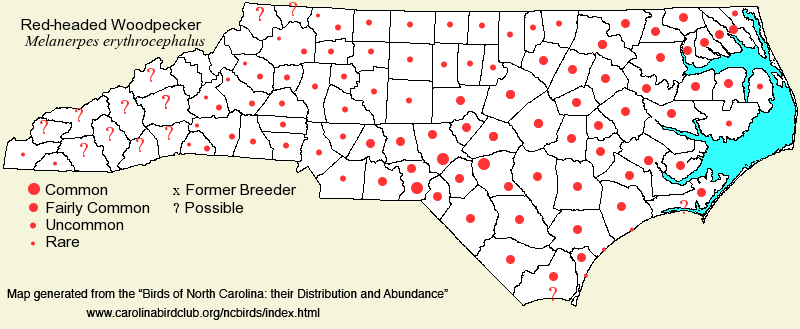 |  |
|
Red-headed Woodpecker - Melanerpes erythrocephalus PICIDAE Members: | Search Common: Search Scientific: |
|
|
|||||||
| General Comments | Arguably one of the world's most beautiful woodpeckers, the Red-headed Woodpecker is noted for its seasonal movements and habitat shifts, often in unpredictable manners. Thus, despite it being a permanent resident in most areas of the state, it can be scarce at certain times of the year; some of these unpredictable shifts are due to scarcity or abundance of the acorn food crop in fall (as the birds can be common during such times). Red-headed Woodpeckers were formerly common over most of the state in the earlier parts of the 20th Century, but the great increase in European Starlings, which favorably compete with woodpecker species for existing tree cavities, caused a considerable decline, though the woodpecker population seems to have been steady over the last few decades. The species has several disparate habitats, though all involve fairly open stands of trees: groves of mature hardwoods (parks, wooded residential areas, cemeteries, etc.), open stands of mature pines (especially Longleaf Pines), and areas with many dead trees (especially at beaver ponds). In winter, birds typically leave the open pine stands, and there is more use of beaver ponds and other areas with an abundance of dead trees. Usage of open stands of mature hardwoods tends to remain fairly constant all year. | ||||||
| Breeding Status | Breeder | ||||||
| NC BRC List | Definitive | ||||||
| State Status | |||||||
| U.S. Status | |||||||
| State Rank | S4B,S4N | ||||||
| Global Rank | G5 | ||||||
| Coastal Plain | Permanent resident, with migratory movements. As a breeder, uncommon to locally fairly common over nearly all of the region, most frequent in Longleaf Pine stands such as in the Sandhills (where locally common) and in the southeastern portion of the province. Rare to locally absent at all times along the immediate coast (such as the Outer Banks and other barrier islands). In winter, locally uncommon to fairly common in most areas, though it moves away from pine stands and is more frequent in swamps and beaver ponds where there are abundant dead trees. Unpredictable in some movements, and quite variable numbers from one winter to the next. Peak counts: ? | ||||||
| Piedmont | Permanent resident, with some migratory movements. In summer, uncommon to fairly common, but in more restricted habitats than for most other woodpecker species. In winter, more unpredictable, though still typically uncommon to fairly common. Less numerous at all times in the foothills, where it may be locally rare. Peak counts: ? | ||||||
| Mountains | Scarce at all seasons, with migratory movements. Formerly (many decades ago) was a regular breeder in the lower elevations, but at present is a very rare to rare and sporadic breeder below 2,500 feet, and probably absent above 3,000 feet, though one was seen excavating a nesting cavity at 3,450 feet elevation in northeastern Watauga on 7 Jul 2021. Most frequent in fall migration, when uncommon but can be seen even at higher elevations. In winter, mostly rare and typically only below 3,000 feet. Peak counts: 14, Carvers Gap (at Roan Mountain), 12 Sep 2004; 7, Asheville, 29 Sep 2004. | ||||||
| Finding Tips |
It is fairly easy to find in open Longleaf Pine forests, at least in the breeding season. Croatan National Forest, Holly Shelter Game Land, and the Sandhills Game Land are good places for them. Also, it can be fairly easy to find in larger beaver ponds with many dead trees. It can be more unpredictable in the winter season, depending on the fall acorn crop. *** | ||||||
| Attribution | LeGrand[2023-03-22], LeGrand[2021-11-07], LeGrand[2012-07-14] | ||||||
| NC Map Map depicts all counties with a report (transient or resident) for the species. | Click on county for list of all known species. |
| NC Breeding Season Map Map depicts assumed breeding season abundance for the species. |  |